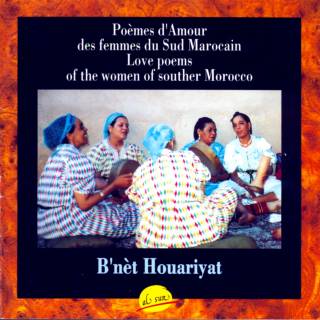My encounter with the music of the houariyat, the women of the Houara (an ethnic group based between Taroudant and Tiznit in Southern Morocco), is closely related to my fieldwork among the Gnawa, begun in 1977 (Baldassarre 1986, 1997, 1999; Taviani and Baldassarre 1997, Schuyler 1997). In the summer of 1992 in Tamesloht - a village a few miles from Marrakech which is the destination of the annual pilgrimage (moussem) to the sanctuary of the local marabout - Rabi`a Rouham, one of the women who had come from Casablanca for the occasion, invited a group of houariyat to animate a small party and enliven the atmosphere before the beginning of the Gnawa's nocturnal ritual. Five elderly women in traditional clothes arrived from Marrakech in the late afternoon. Having been greeted according to customary formulas, they were taken to the ryad, the internal courtyard of the house, where a mat was laid out for them. The women sat in a circle, produced some percussion instruments out of their bags, tested their tuning, and began their work. Their "performance" lasted for one hour and a half approximately, with a few intervals during which the traditional mint tea and pastries were served. All participants appeared to enjoy the houariyat's performance, and many accompanied the music by clapping their hands and dancing. As I had a DAT with me I managed to record some of the final pieces which they played. When I had the opportunity to listen again to the recording, and to translate the content of the songs, I was impressed with the virtuosity of their polyrhythmic patterns and the lyrics which succeeded. At the end of the moussem, on my way back to Marrakech, I suggested Rabi`a that she might organize another feast animated by the houariyat, which woudl take place the following year in the same place and under the same circumstances. In return for their hospitality, I was to provide the musical entertainment, and thus pay for the musicians and the refreshment for the participants. Moreover, if the houariyat agreed, I was to record their songs with professional equipment, and to eventually produce a CD. Rabi`a agreed willingly, and before returning to Casablanca she put me in contact with the person who had provided the group of houariyat: a lady who worked as a nagafa, i.e. a professional organizer of wedding feasts. Rabi`a asked the nagafa to look for the best group of houariyat available in Marrakech and surroundings and arranged to meet again in the following year. In September 1993 I returned to Tamesloht to attend the Gnawa's moussem. On the set day, Sunday 12th, a group of six houariyat arrived from Marrakech. They looked younger than their colleagues of the previous year, and I noticed that four of them wore similar tunics as a sort of common work uniform. Before they began to play, I clarified my intentions, and we agreed upon a fee for their performance. Thanks to their professional ability, the musicians also picked up the ghorama, the spontaneous donations of the participants, during the feast. The houariyat remained with us for approximately two hours, and played for a little longer than one hour.
Once their work was over, I offered to take the six women back to Marrakech: the four who wore similar costumes got in my car, while the other two went on the car of a Moroccan friend. During our short journey, almost for fun we chose a name for the group in case their music was to meet with interest abroad: B'net Houariyat (The Daughters of the Houara) was approved unanimously. A few months later, the first CD of the B'net Houariyat was released in Paris (2). The
cover of the first CD |
 Recording "Poèmes d'Amour"
Recording "Poèmes d'Amour"
